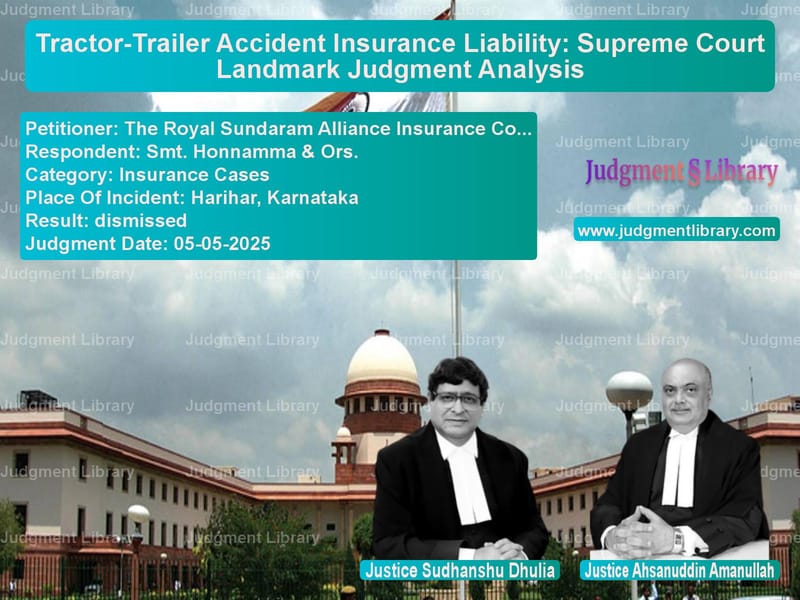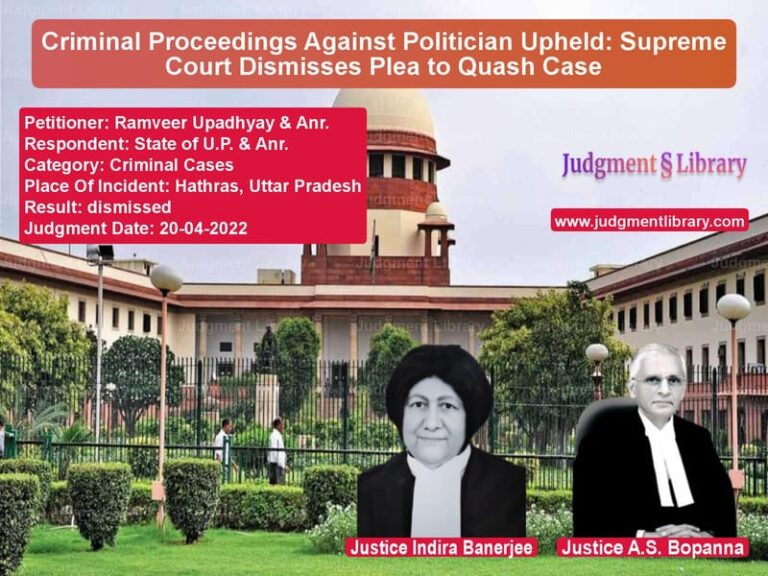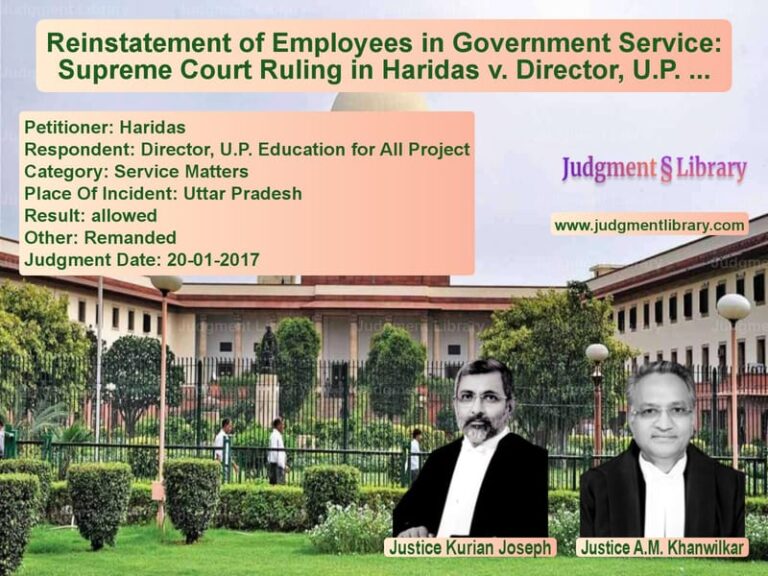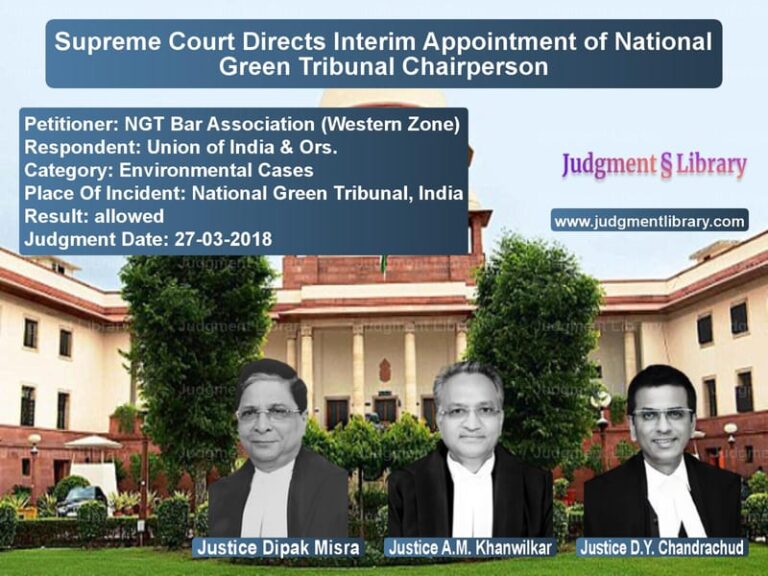Tractor-Trailer Accident Insurance Liability: Supreme Court Landmark Judgment Analysis
In a significant ruling that balances legal technicalities with ground realities, the Supreme Court of India recently delivered a judgment that clarifies the insurance liability in cases involving tractor-trailer accidents. The case involved a tragic incident where a laborer lost his life while working on a trailer attached to an insured tractor, raising important questions about where the liability should fall when multiple vehicles are involved in an accident.
The legal journey began on February 29, 2012, when Nagarajappa was traveling in a tractor and trailer as a coolie to unload soil. Due to the rash and negligent driving of the tractor driver, the vehicle toppled, causing fatal injuries to Nagarajappa. His grieving family – wife Honnamma and two minor daughters Bhagya and Ramya – filed a claim before the Motor Accident Claims Tribunal (MACT) seeking compensation of Rs. 10,00,000 for their irreparable loss.
After examining evidence from both sides, including documents marked as Exhibits P1 to P10 by the claimants and R1 to R7 by the insurance company, the MACT partly allowed the claim. The Tribunal awarded compensation of Rs. 9,50,000 with 6% annual interest from the date of filing the petition. However, in what would become the central legal controversy, the MACT held that the risk of employees of the tractor and trailer was not statutorily covered under Section 147(1)(b) of the Motor Vehicles Act, 1988. Consequently, the Tribunal fastened liability on the vehicle owner and driver, exempting the insurance company from responsibility.
Unsatisfied with both the compensation amount and the exoneration of the insurance company, the claimants approached the High Court of Karnataka. The High Court, in its order dated November 25, 2022, partly allowed the appeal and enhanced the compensation to Rs. 13,28,940 while maintaining the 6% interest rate. More significantly, the High Court reversed the MACT’s decision on liability and fastened the responsibility to pay compensation on Royal Sundaram Alliance Insurance Company, the appellant before the Supreme Court.
The Insurance Company’s Arguments
Before the Supreme Court, the insurance company mounted a vigorous defense, arguing that the High Court had erroneously reversed the MACT’s well-reasoned decision. The appellant’s counsel contended that the insurance policy did not extend coverage to the trailer or employees of the owner or any passenger traveling on the trailer. Despite categorical options for risk-coverage of these categories, the policy-holder had not subscribed to such coverage.
The insurance company pointed out that the High Court had taken a naive and simplistic view of the matter, ignoring the respondent’s categorical admission regarding rash driving. They also emphasized that Respondents No. 4 and 5 (the vehicle owner and driver) had accepted the MACT’s order by not challenging it, implying that the liability determination should stand.
Another significant argument raised was that the High Court had awarded compensation exceeding what was originally prayed for in the claim petition. The appellant also contended that the award was not in accordance with the established principles laid down in Sarla Verma v Delhi Transport Corporation, the landmark case that provides guidelines for calculating compensation in motor accident cases.
The insurance company relied heavily on two key precedents. From New India Assurance Co. Ltd. v C M Jaya, they drew the principle that compensation cannot exceed the limits of the insurance policy. From Dhondubai v Hammantappa Bandappa Gandigude, they argued that liability cannot be fastened on the insurance company when the deceased was traveling in an uninsured trailer.
The Supreme Court’s Analysis and Reasoning
The Supreme Court bench comprising Justices Sudhanshu Dhulia and Ahsanuddin Amanullah began by acknowledging that the case raised mixed questions of fact and law that required harmonious balancing. The court noted the admitted facts: the incident occurred while a tractor insured with the appellant was attached to a trailer, and a person on the trailer fell off due to the accident, resulting in his death.
The court observed: “Therefore, the undisputed position is that the trailer was being pulled by/attached to the tractor and then the trailer on which the deceased was present, turned turtle/upturned, resulting in his death. From the above, it is clear that the tractor which was insured was the reason for the accident. It is not the case that only because of some fault on the part of the trailer stand-alone, the accident happened.”
To illustrate this point, the court provided a clarifying example: “To explain, we may give an example: that had the trailer been stationary at a place and due to some reason, it overturned or a mishap happened, then without the trailer being specifically insured the Appellant would not be liable to pay, but here the main cause of the accident was the tractor which was pulling/driving/moving the trailer and in such sequence of events, the trailer upturned. Thus, the accident was caused by the tractor, as during the course of being driven/pulled by the tractor, the accident occurred.”
This reasoning led the court to conclude that “the liability of the tractor/its insurer extended to the accident caused by the tractor resulting in the death of the deceased, through the trailer.” The court distinguished the present facts from cases where courts have held that trailers must be separately registered with the insurance company to create liability.
The judgment emphasized the beneficial and welfare-oriented nature of the Motor Vehicles Act, citing precedents like Ningamma v United India Insurance Co. Ltd., K Ramya v National Insurance Co. Ltd., and Shivaleela v Divisional Manager, United India Insurance Co. Ltd. The court stated: “ultimately the root cause of the accident being the tractor, which was insured, this crucial fact cannot be lost sight of.”
The court further elaborated with an analogy: “For further clarification, we might illustrate: if an insured vehicle hits another vehicle which in turn hits a third vehicle, then for the entire chain of accidents, the liability would pass on to the vehicle which was the root cause of the accident because it is the result of the action in the same chain of events which cannot be segregated or compartmentalized.”
Addressing the insurance company’s reliance on Dhondubai, the court noted that the precedent did not lay down an absolute principle of law. The court pointed out that in Dhondubai itself, the insurance company was directed to pay the compensation and then recover it from the vehicle owner. The judgment also referenced a Division Bench decision of the Andhra Pradesh High Court in United India Insurance Co. Ltd., Kadapa District v Koduru Bhagyamma, which held that no separate insurance is contemplated for a trailer under the Motor Vehicles Act.
The court reproduced a significant paragraph from the Andhra Pradesh High Court judgment: “Now on analysis of these judgments and the provisions of law which have been quoted above, we feel that the law has been correctly appreciated by a learned Single Judge of this Court in Gunti Devaiah v. Vaka Peddi Reddy (supra) and the reasons given by him are sufficient to hold that under the Motor Vehicles Act no separate insurance is contemplated for a trailer and when the trailer is attached to the tractor which is insured, it becomes the part of the tractor.”
Examination of Insurance Policy and Legal Principles
The Supreme Court then turned to the specific insurance policy in question, noting relevant clauses that excluded coverage for certain uses and specified limits of liability. The policy stated it did not cover: “Use for the Carriage of passengers for hire or reward” and “Use whilst drawing a greater number of trailers in all than is permitted under law.” More importantly, the policy specified limits of liability: “Under Section 11-1 (i) of the Policy – Death of or bodily injury – Such amount as is necessary to meet the requirements of the Motor Vehicles Act, 1988.”
The policy also contained specific entries for trailers and coolies with zero premium, indicating that no additional coverage had been purchased for these categories.
The court extensively discussed Section 147 of the Motor Vehicles Act, 1988, which outlines the requirements of insurance policies and limits of liability. This analysis was crucial in determining whether the insurance company could be held liable beyond the statutory requirements.
The judgment revisited the landmark 5-judge bench decision in C M Jaya, which harmonized earlier conflicting precedents on the extent of insurer liability. The court quoted the principles established in that case: “Thus, a careful reading of these decisions clearly shows that the liability of the insurer is limited, as indicated in Section 95 of the Act, but it is open to the insured to make payment of additional higher premium and get higher risk covered in respect of third party also. But in the absence of any such clause in the insurance policy the liability of the insurer cannot be unlimited in respect of third party and it is limited only to the statutory liability.”
The court further noted the principles from Shanti Bai case: “(i) a comprehensive policy which has been issued on the basis of the estimated value of the vehicle does not automatically result in covering the liability with regard to third-party risk for an amount higher than the statutory limit, (ii) that even though it is not permissible to use a vehicle unless it is covered at least under an ‘Act only’ policy, it is not obligatory for the owner of a vehicle to get it comprehensively insured, and (iii) that the limit of liability with regard to third-party risk does not become unlimited or higher than the statutory liability in the absence of specific agreement to make the insurer’s liability unlimited or higher than the statutory liability.”
The Court’s Conclusion and Final Directions
After this comprehensive analysis, the Supreme Court reached its conclusion: “What emerges is that the Appellant ought not to be saddled with payment of compensation exceeding what the insurance policy provides for or the limit, if any, set under any law for the time being in force, whichever be the higher amount of the two, in the underlying factual scenario. The amount exclusively payable by the Appellant, however, shall in no case be less than Rs.9,50,000/- (Rupees Nine Lakhs Fifty Thousand).”
The court found no infirmity in the High Court’s order regarding either the quantum of compensation awarded or the fixation of liability on the insurance company for the accident. However, recognizing the contractual and statutory limitations on the insurer’s liability, the court granted the insurance company liberty to recover any differential amount from the vehicle owner.
The court directed: “However, liberty is granted to the Appellant to recover the differential amount (if any), in terms of Paragraph 18 supra i.e., total compensation awarded less the maximum amount payable, contractually or as per law (whichever be the higher amount), by the Appellant, from the Respondent No.4-owner.”
The Supreme Court dismissed the insurance company’s appeal while maintaining the High Court’s enhanced compensation amount of Rs. 13,28,940. The court ordered that this amount be paid within two months after adjusting whatever had been paid earlier, in terms of a previous order dated February 6, 2023.
This judgment represents a significant interpretation of insurance liability in composite vehicle accidents. While recognizing the technical limitations of insurance policies, the court prioritized the beneficial purpose of the Motor Vehicles Act and the practical realities of how tractor-trailer combinations operate. The decision ensures that victims of accidents receive compensation while providing a mechanism for insurance companies to recover amounts beyond their contractual obligations from the responsible vehicle owners.
The Supreme Court’s approach demonstrates a balanced application of legal principles – acknowledging the contractual nature of insurance policies while ensuring that technicalities do not defeat the fundamental purpose of compensation legislation. The judgment reaffirms the court’s role as a protector of victims’ rights while respecting the boundaries of insurance contracts, creating a precedent that will guide similar cases in the future.
Petitioner Name: The Royal Sundaram Alliance Insurance Company Limited.Respondent Name: Smt. Honnamma & Ors..Judgment By: Justice Sudhanshu Dhulia, Justice Ahsanuddin Amanullah.Place Of Incident: Harihar, Karnataka.Judgment Date: 05-05-2025.Result: dismissed.
Don’t miss out on the full details! Download the complete judgment in PDF format below and gain valuable insights instantly!
Download Judgment: the-royal-sundaram-a-vs-smt.-honnamma-&-ors.-supreme-court-of-india-judgment-dated-05-05-2025.pdf
Directly Download Judgment: Directly download this Judgment
See all petitions in Motor Insurance Settlements
See all petitions in Third-Party Insurance
See all petitions in Insurance Settlements
See all petitions in Compensation Disputes
See all petitions in Motor Vehicle Act
See all petitions in Road Accident Cases
See all petitions in Judgment by Sudhanshu Dhulia
See all petitions in Judgment by Ahsanuddin Amanullah
See all petitions in dismissed
See all petitions in supreme court of India judgments May 2025
See all petitions in 2025 judgments
See all posts in Insurance Cases Category
See all allowed petitions in Insurance Cases Category
See all Dismissed petitions in Insurance Cases Category
See all partially allowed petitions in Insurance Cases Category







